The best bet for such a population representing a vestige of the Sayabiga may be the Agotes of northern Spain, and related peoples in neighboring lands. Although I have suggested the Sayabiga were mainly concentrated in coastal northeastern Spain, i.e., Valencia, they could have traveled more broadly into the Muslim-held areas, and even further if they converted to Christianity.
The Agotes belong to a set of peoples known as Cagots, Agotacs, Gafets and Gahets in France; and as Cacous in Lower Brittany. In Spain, they are known in Asturias as Vaqueiros; as Maragatos in Leon; and as Agotes in Navarre. However these names are mostly of latter origin. In many areas, the Agotes at some point in history became out-castes, which may have helped in preserving them as a separate group. In the 19th century though, bans were placed on practices that discriminated against the Agotes and they began mixing with the rest of the population. Although they have mostly disappeared as a separate group there are still people today who can trace their descent back to the Agotes.
A group apart
The textual references of the Agotes and related peoples make it clear that they were seen to be different both culturally and also in terms of their appearance from the rest of their neighbors. The references about their appearance are late and a bit confused, for example, here is a description of those who lived in the Ribas Valley of northwestern Gerona:
"They never exceed 51 1/2 inches in height, and have short, ill-formed legs, great bellies, small eyes, flat noses, and pale, unwholesome complexions."
Another source states:
"Their language is merely a corrupt form of that spoken around them; but a Teutonic origin seems to be indicated by their fair complexions and blue eyes. Their crania have a normal development; their cheek-bones are high; their noses prominent, with large nostrils; their lips straight; and they are marked by the absence of the auricular lobules."
And yet again:
"In personal appearance almost all may be distinguished by their grey eyes, short noses, thick lips, very short auricular lobes, and sad looks. It has been said that the Agotae are short lived, but instances are cited of centenarians amongst them. They follow chiefly the occupations of carpenters, blacksmiths, masons, turners, and above all of millers; indeed, in certain localities, to be a miller is considered the equivalent of an Agotae."
In some cases they are said to be dark, but other sources describe them as fair. Dudley Costello, writing in the mid-19th century gives an explanation for the discrepancy:
The most interesting of these tribes are undoubtedly the Cagots of the Pyrenees, so persecuted by the authorities in Bearn in 1596. These have often been confused with diseased idiotic subjects like the cretins of the Alps, from whom they differ in many respects. E.g. the cretin is sually afflicted by goitre, and possesses an extremely small semi-idiotic brain: but the Cagot is apparently a normal example, and the intelligence of many male, and beauty of many female Cagots, have become proverbial. They are specially characterised by a peculiarly formed ear, sessile with, yet brusquely exserted from the head, small bright blue eyes, very large skulls, often of considerable breadth, short necks and frequently bowlegs. Two sorts exist, one with white skin and flaxen hair, the second deeply bronzed, with crisp woolly hair, grey eyes, and high cheekbones.
The Agotes and related peoples were carpenters and masons and tradition states they were responsible for building many Romanesque churches and other buildings including the Jaca Cathedral, Santa Cruz de la Seros and San Pedro de Siresa. The sculpture of the Romanesque period contains a broad array of physical types that probably includes some sculpture created by Agotes representing their own physiognomy. Of course, Spain was a highly multicultural and multiethnic region at this time, so one would have to pay close attention to detail in this area. Also, the Sayabiga do appear to have been as endogamous as the Gitano. At some point, if the Agote peoples do represent remnants of the Sayabiga, they became out-castes and intermarriage became rare (but not unheard of).

Puerta del Perdón. Tímpano. San Isidoro de León. España from Wikipedia.
Click here for full size image. See more images below.
Culturally, the Agote type people once lived in huts, some with thatched roofs, that were often secluded deep in the forest. Those that practiced transhumant herding or woodcutting often had multiple huts in which they lived in at different times of the year. They had settled mainly in mountainous areas and the adjoining valleys. Most were employed as carpenters, woodcutters, masons, and builders
History of the Agote peoples
The precise date at which the Agote and related folk appear is hard to pin down exactly. They have been variously given Visigothic, Morisco, Viking, Albigenses, Cathar, "Tartar," Jewish/Marrano and other origin.
When they became out-castes, the Agote were forced to wear a dried goose foot painted red on their shoulder; or else a piece of red or yellow cloth cut in the shape of a goose's or duck's foot. According to some texts, the Agote had webbed feet like a goose.
In relation to this legend, the Basques have myths of the Laminak, a race of fairies with goose feet. In Toulouse where the Cagots dwell, there is the legend of La reine pédauque "The Goose Foot Queen," and the region is even known as Pays d'Oc "Land of Goose," and the language is Languedoc "Goose Language."
Supposedly, this goose-footed queen was Bertha, the mother of Charlemange who was also known as Berthe aux grand pieds because of her large, broad feet (she is also known as Bertha Broadfoot) that caused her to waddle like a goose.
The goose feet apparently had some ethnic connotations as the Agote peoples themselves were said to have goose-like feet and were also called Canards or "Ducks." Eventually, the goose foot became a type of esoteric symbol and emblem of the Agotes. Many of the churches attributed to Agote builders are marked with a goose foot symbol, a crucifix shaped like a goose's foot, or a statue of Bertha Broadfoot on the facade with a crown, a distaff in hand, and goose or swan's feet.
Camino de Santiago
During the Romanesque period, a great pilgrimage to Santiago de Compostela in Galicia became widely popular, as this was said to be the location where the Apostle James was buried. While there had been other pilgrimage routes like the Via Francigena leading to Rome previously nothing really compared to the "Way of St. James."
The Camino de Santiago running through northern Spain from the Pyrenees to Galicia has been linked by many researchers with the Agote peoples. Firstly the route runs through the areas closely associated with Agotes and many of the important churches and buildings are marked with the goose foot symbol or have crucifixes in the goose foot shape. Many esoteric scholars also associate the common scallop shell symbol found along this route with the goose foot.
A photo of a goose's foot beside a photo of a goose foot symbol at Cementerio de Santa María de Adina, Iria Flavia (Source: http://laberintoromanico.blogspot.com/2008/02/el-juego-de-la-oca-la-pata-coja.html)
A crucifix in the shape of the stylized goose foot at the Templo del Crucifijo, Puente la Reina in Navarre along the Way of St. James dating to the 13th-14th century.
Scallop shell symbols are found on fountains, wall and other structures all along the Camino de Santiago.
Various theories are connected with these symbols. The camino is located along an old Roman trail that was supposed to follow the Milky Way to the sea. Thus, some esoteric scholars connect the scallop shell and goose foot to constellations. Others see the scallop as a fertility symbol linked with the goddess Venus, and the shell does have a womb-like shape.
Louis Charpentier in 1973 noted the large number of place names that included the word for "goose" along the Camino, and it has been suggested that the Juego de la Oca or Goose Game originates from the Camino de Santiago pilgrimage. In this game, there are 63 squares leading in a spiral-like path to the 64th central square that contains the image of a goose. There are also images in the other squares including geese, which are auspicious to land on, and less lucky squares containing images of obstacles, prisons and the like.
The goose connection here may lie in the goose-footed Agotes who built or helped to build many of the important structures along the Camino de Santiago.
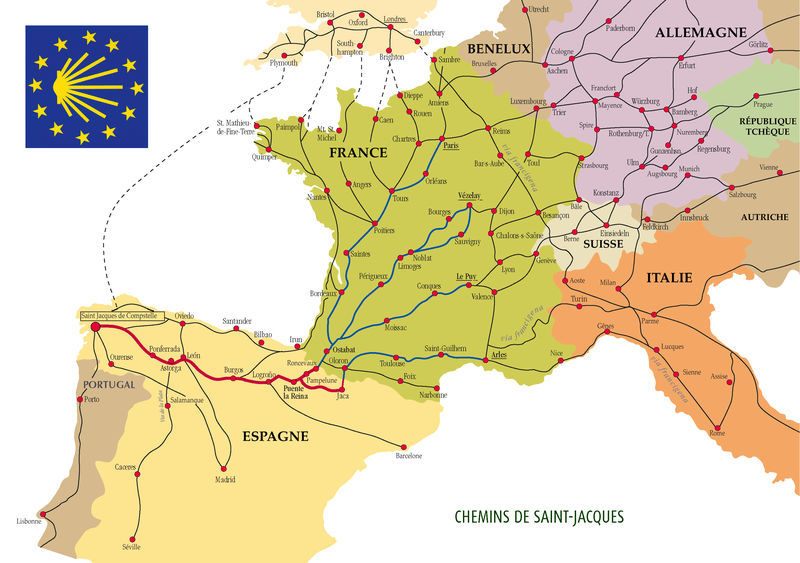
Camino de Santiago marked in red (Source: http://en.wikipedia.org/wiki/File:Stjacquescompostelle1.png). Click here for full image.
Geese provide a link with the fairy folk that have been described in many places in this blog. Bertha Broadfoot herself, who becomes the wife of Robert II of France in latter legend, was known to tell tales to children while sitting by her spinning wheel, and some believe that "Mother Goose" of the fairy tales is derived from La Reine Pédauque "the Goose Foot Queen."
As geese and swans were interchangeable in medieval lore, we can also see a connection between the fairy Swan Knight, and the goose footed Agotes and Bertha Broadfoot.
Grail connection
In Jüngere Titurel, following Wolfram von Eschenbach's linkage of the Grail family with the Angevins, the author takes the story back to late ancient times. They come from Cappadocia, which is not far from Antioch where both the Zutt and the Sayabiga were transported in the early 8th century.
According to the story, the pagan prince Sennabor helps the Roman emperor against other pagans and is converted to Christianity. In return, the emperor grants one of Sennabor's three sons, Parille, some French provinces, while Azubar is granted Anjou, and the third son, Sabbilar, receives Cornwall. The link in with Wolfram is clear here along with a justification of the Angevin's Gallic claim to England.
In order to bring the Grail family into medieval times, Parille's grandson Titurel, the first Grail King, is said to live past 400 years in age. Titurel was located in a region between Navarre and Aragon, although the area that was called Salvaterra can be seen as a form of Jerusalem and the Holy Land. Titurel marries a daugher of Frimutelle, a king of a Spanish province. Thus, the Grail family is placed in basically the same area as that associated with the Agote, and which formed a part of the Camino de Santiago. The doctrine of the Grail is said to have radiated from there to Aragon and then in order to Navarre, Catalonia and eventually beyond Spain. Wolfram also makes the Spanish connection placing Parzival's mother Herzeloyde, a member of the Grail family, in the country but without giving a precise location.
Eastern influences in Romanesque art
Millard B. Rogers in 1960, and Mercia MacDermot in 2003 have published convincing studies showing Indic influences in Romanesque art. These findings are summarized at this webpage: http://www.beyond-the-pale.org.uk/column.htm. Millard concentrated on the art found on the Camino de Santiago.
Most important are the close similarities of the column-swallowers and the foliage-spewer motifs in Romanesque art to the kirtimukha motif in Indic art of South and Southeast Asia. Indeed some of the reliefs along the Camino de Santiago look more similar to what one would find in medieval Borobudur or Bhubaneswar rather that of pre-Romanesque or even post-Romanesque Europe.
From the aforementioned site:
"What are we to make of this 15th century carving at Candi Sukuh in Java which, apart from the typical Hindu hair-style, could have come from a 12th century church in France ?" http://www.beyond-the-pale.org.uk/column.htm
In the following photo of a tympanum from Santiago de Compostela Cathedral, we see what could be images of winged monkeys. These might be derived from Hanuman and his army of flying monkeys, and Hanuman himself was sometimes depicted in text and art as having wings.
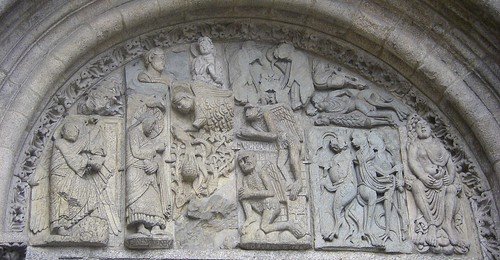
Winged monkeys, Santiago de Compostela, the legendary burial place of Apostle St. James. Click here for full size image. (Source: http://www.flickr.com/photos/thecolchesterkid/2925988533/)
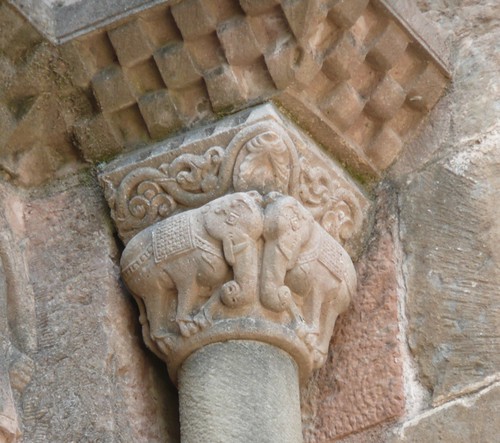
Elephants, apparently Asian as evidenced by their head shape, small ears, and squarish bodies, and by the rigging. Sant Joan de les Abadesses, 12th century in northern Catalonia. (Source: http://www.flickr.com/photos/21086430@N00/2451054893/)
Conclusion
If Parzival and Jüngere can be viewed be viewed as semi-legendary "histories" relating to events of the 12th and 13th centuries, as suggested earlier in this blog, then the "Grail family" -- the fairy folk -- would have come from the Near East to Spain. In my view, these travelers would have come along with the other Sayabiga maybe as early as the early 8th century.
While most of this population settled in coastal areas like Valencia, where evidence of their presence can be seen in the tidal rice and related cultural elements that still persist, some would have ventured to other areas of the Moorish kingdoms. Here, the higher elevations, cooler climate and other ecological and social factors would have forced them to abandon rice cultivation and adopt a more local diet. During the Reconquista, populations in the mountainous northern parts may have adopted Christianity early including the "Grail family" but still keeping contacts with their cousins along the coast, and ultimately in the Indies. For this reason, the Grail and the characters of the Grail epics are repeatedly connected with distant lands to the East and with "Prester John."
The Sayabiga carried elements of Indic and "Tantric" culture with them that can be seen in Romanesque art forms.
An interesting test of this suggestion would be to examine whether the Agotes and related peoples possibly extending to the Bigaudens of Brittany left any linguistic influences on the local languages. Genetic tests might also be able to reveal something, although these people eventually did intermix extensively.
Here are some more examples of Spanish Romanesque art that may include some self representation of the Agote masons themselves, i.e., Sayabiga or more likely mixed Sayabiga physical traits.

Organistrum de Iglesia de Ahedo del Butrón (Burgos) España s. XII (Source: Wikipedia)

Puerta, Santiago de Compostela (Source: Wikipedia) Click here for full image.

Betanzos (Source: Wikipedia). Click here for full image.
 |
| Sacrifice of Isaac, Cathedral of Jaca (Source: http://www.wga.hu/frames-e.html?/html/zgothic/1romanes/cap-11c/25s_1000.html). |
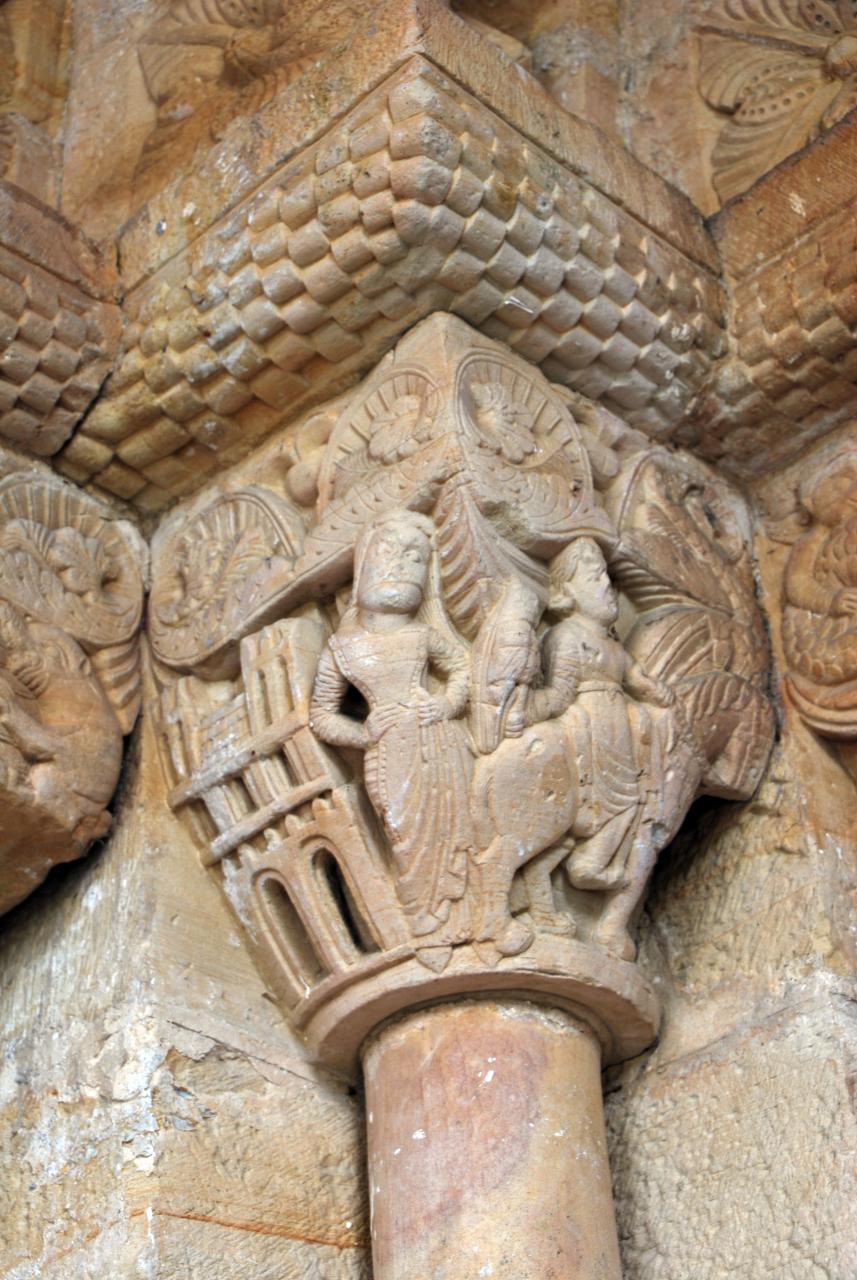
Monasterio de San Pedro de Villanueva, Cangas de Onís, Asturias, Spain. Portada Sur (Source: http://www.flickr.com/photos/c0ntraband/3958198252/in/photostream). Click here for full image.
Regards,
Paul Kekai Manansala
Sacramento
References
Costello, Dudley. "The accursed races of France and Spain," Quarterly Magazine of the Independent Order of Odd Fellows; Manchester Unity Friendly Society, 1860, 92.
Facaros, Dana, and Michael Pauls. Northern Spain. London: Cadogan Guides, 2008, 38.
Gould, George M., and Walter L. Pyle. Anomalies and Curiosities of Medicine. Teddington, Middlesex: Echo Library, 2007.
MacDermott, Mercia. Explore Green Men, Heart of Albion Press, 2006
Merke, F. History and Iconography of Endemic Goitre and Cretinism. Lancaster: MTP Press, 1984, 199.
Muñoz, Patricia, R. El Camino de la Oca, http://patadeoca.blogspot.com/.
Piñuela, M. Garcia, Los Agotes, http://www.portalfarma.com/pfarma/taxonomia/general/gp000012.nsf/voDocumentos/95B978F353404068C1256A49002C4F9C/$File/mitologia.pdf.
Prosser, Randall P. American Phonetic Journal. Cincinnati: R.P. Prosser, 1855, 162.

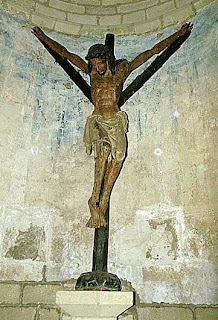
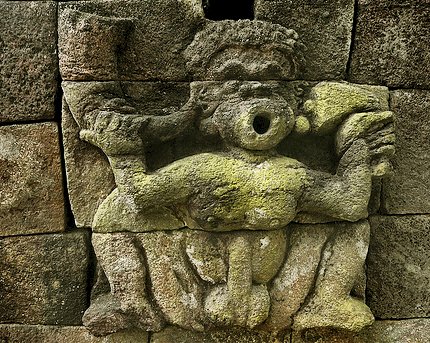







6 comments:
Dear Paul,
I read your article with great interest (I came to it because you have quoted some of my work). I am familiar with some of your content but not everyone would agree with all of it. For example, the origin of the "langue d'oc". It is usually thought that the word for "yes" was "oui" or "oïl" in the North of France and "oc" in the South, so that the two dialects became known as the "languedoïl" and the "languedoc", hence the designations for the two halves of the country, as it developed.
Best wishes, Julianna
http://www.green-man-of-cercles.org/
Hi Juliana,
Yes, this is the popular etymology.
I should have discussed this, but did not want to go off on too much of a tangent.
The general argument is that languedoc is derived from langue d'oc and that "oc" comes from the Latin affirmation compound "hoc illud."
Thus you also get o-il in northern France, although some have argued for something like o + ille meaning "yes, he" or "yes, they" with "o" has a shortened form of "hoc."
The languages of the north are thus also called langue d'oi or langue d'oie, which supposedly is related to the modern French form oui "yes."
To compound this, you have Dante mentioning a "lingua del Si."
I believe though that this may have arose from folk etymologizing.
The original langue d'oc would, in my view, be related to "la reine Pedauque" i.e., the "goose-footed queen."
Pedauque is from pe d'auque "foot of a goose" and is also found in the form pied d'oie as in the alternate name for the queen "la reine Pied-d'Oie." Also, the probably identical queen Berthe aux pieds d'oie "Bertha with the goose feet."
Both "auque" and "oie" have the meaning goose, auque in the south, while oie is the northern form.
Some other examples of old words for goose in the Occitan region and from neighboring areas are:
auc -- Limousin
ooch -- Cremonese
oche -- Berrichon
oche -- Jaubert
aouque -- Bayonne
ocque -- Isere
auche, auch -- Gras
auc, aouc -- Castres
These words are related to Spanish and Catalan oca "goose."
We also have the same relationship probably in the name for the "Goose Game" or Juego de la oca in Spain.
In France, the same game is known as Jue de l'oie, or Jardin de l'Oie "Garden of the Goose."
The form oil or oi'l might be a shortened form of Bourguignon ouilotte "small goose." Some known variant forms are ouille, ouillon and olle.
Statues of the la reine Pedaque and Berthe aux pieds d'oie (aka Berthe aux grand pieds "Bertha of the Great Feet") were found on the facades of many churches in France.
So, basically I believe that originally langue d'oc meant language of the goose in relation to the popularity of the goose-footed queen, and possibly also to some more esoteric connections of the goose (including the Agote connection).
Later, this was folk etymologized to langue d'oc "language of yes."
Let me add that the Languedoc area first appears not by that name but by cognates of modern "Occitan" as in "lingua Occitana" in the 1215 charter lf Louis Hutin, and the "lingua Auxitana" used by his father Philip the Handsome.
For some discussion on this see JE Biester, "On co and Oyl," in Philological Museumm vol. 2, 1833.
Biester connects this "oc" or "aux" with Auch, the capital of Gascony, and with the affirmative "och" in Gascony.
But Auch could also come from the Gascon word for goose, and Gascony is famed as a place where "there are more geese than people."
Dante may have confused the "oc" in Occitana with oc "yes."
In fact, Provencal was not only the land of oc, but also the land of si, o, oco, oi, and ou-i, all of which could mean "yes."
That should be the "1315 charter"...
Dear Paul,
I had imagined the affiliation to have a Hindu connection to Sanskrit Hamsa “Swan” or “Goose” and the notable connection between Saint James and Castor and Pollux being hatched from “swan” eggs. I had thought it was a clever hidden meaning in the “spiritual journey” to the “divine abode.” The swans represented the “way” into “paradise,” and a return to the Garden of Hesperides. Hamsa “divine knowledge.” Being that the Zohar first appeared in Spain during that time, the amalgamating cauldron between Mesopotamian and Indian cultures.
I would love your opinion.
Thank you,
Rachel Lowder
Hi Rachel,
It certainly makes sense that the ultimate "hidden meaning" would relate to the final journey to the divine abode/presence.
Here are some other related posts I have made that relate to the Zohar and Kabbalah:
http://sambali.blogspot.com/search?q=kabbalah
Post a Comment